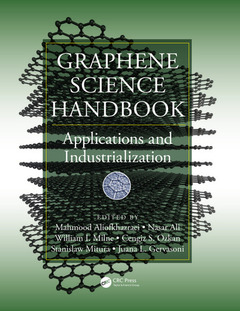Graphene Science Handbook Applications and Industrialization
Coordonnateurs : Aliofkhazraei Mahmood, Ali Nasar, Milne William I., Ozkan Cengiz S., Mitura Stanislaw, Gervasoni Juana L.

Explore the Practical Applications and Promising Developments of Graphene
The Graphene Science Handbook is a six-volume set that describes graphene?s special structural, electrical, and chemical properties. The book considers how these properties can be used in different applications (including the development of batteries, fuel cells, photovoltaic cells, and supercapacitors based on graphene) and produced on a massive and global scale.
Volume One: Fabrication Methods
Volume Two: Nanostructure and Atomic Arrangement
Volume Three: Electrical and Optical Properties
Volume Four: Mechanical and Chemical Properties
Volume Five: Size-Dependent Properties
Volume Six: Applications and Industrialization
This handbook describes the fabrication methods of graphene; the nanostructure and atomic arrangement of graphene; graphene?s electrical and optical properties; the mechanical and chemical properties of graphene; the size effects in graphene, characterization, and applications based on size-affected properties; and the application and industrialization of graphene.
Volume six is dedicated to the application and industrialization of graphene and covers:
- The design of graphene- and biomolecule-based nanosensors and nanodevices
- The use of graphene-based field-effect-transistor (GFET)-like structures as sensing substrates and DNA aptamers as sensing elements
- Recent advances in graphene-based DNA sensors
- The antibacterial properties of graphene-based nanomaterial (NM)
- The chemical and physical properties of graphene and its current uses
- The development of sensitive and selective field-effect transistors (FET) biosensors based on graphene
- The unique properties of ordered graphene (G)
- Various methods currently employed for the production of graphene nanocomposites
- The supramolecular chemistry of graphene derivatives, and more
BIOMATERIAL. NANOCOMPOSITES. ELECTRICAL/SENSOR DEVICES. NEW APPLICATIONS.
Mahmood Aliofkhazraei is an assistant professor in the Materials Engineering Department at Tarbiat Modares University. Dr. Aliofkhazraei’s research interests include nanotechnology and its use in surface and corrosion science. One of his main interests is plasma electrolysis, and he has published more than 40 papers and a book in this area. Overall he has published more than 12 books and 90 journal articles. Aliofkhazraei has received numerous awards, including the Khwarizmi award, IMES medal, INIC award, best-thesis award, best-book award, and the best young nanotechnologist award of Iran. He is on the advisory editorial board of several nanotechnology journals.
Nasar Ali is a visiting professor at Meliksah University in Turkey. Earlier he held the post of chief scientific officer at CNC Coatings Company based in Rochdale, UK. Prior to this Dr. Ali was a faculty member (assistant professor) at the University of Aveiro in Portugal where he founded and led the Surface Engineering and Nanotechnology group. He has over 120 international refereed research publications, including a number of book chapters. Dr. Ali serves on a number of committees for international conferences based on nanomaterials, thin films, and emerging technologies (nanotechnology), and he chairs the highly successful NANOSMAT congress.
William I. Milne, FREng, FIET, FIMMM, was head of the Electrical Engineering Division of the Engineering Department at Cambridge University from 1999 until 2014 and was Director of the Centre for Advanced Photonics and Electronics (CAPE) from 2004 until 2015. He earned a BSc at St. Andrews University in Scotland in 1970 and later earned a PhD in electronic materials at the Imperial College London. In 2003 he was awarded a DEng (honoris causa) by the University of Waterloo, Canada. His research interests include large area silicon-and carbon-based electronics, thin film materials, and, MEMS and carbon nanotubes, graphene, and other 1-
Date de parution : 05-2016
21x28 cm
Thèmes de Graphene Science Handbook :
Mots-clés :
Go; Graphene NSs; sheets; Graphene Sheets; nanosheets; RGO; oxide; American Chemical Society; nanoribbon; Graphite Oxide; reduced; Fuel Cell; graphite; Graphene Nanoplatelets; layer; PEMFC; bilayer; Graphene Nanocomposites; carbon; Energy Densities; nanotubes; ORR Activity; Glassy Carbon Electrode; Polymer Solar Cells; Fg Sheet; Bilayer Graphene; Copyright Wiley VCH Verlag GmbH; Antibacterial Activity; Glucose Oxidase; Proton Exchange Membrane; Graphene Layers; Hydrogen Storage; Solar Cell; Magnetic Eld; PVP



